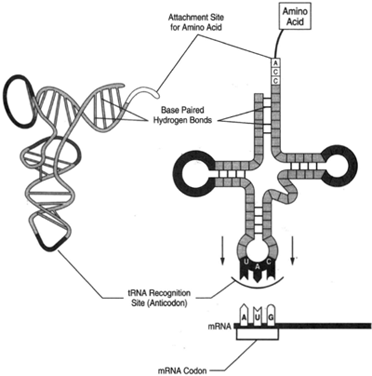Transfer RNA
In order for amino acids to be available to go on line they must be brought to the ribosomes. While m-RNA seems to move without a helper, there is another kind of RNA that acts as a carrier for amino acids and brings them to the place of assembly: t-RNA. There is a different kind of t-RNA molecule for each kind of amino acid. An amino acid needed in the assembly of a polypeptide at the ribosome is escorted by a t-RNA molecule. |
| Figure 6-11 A t-RNA molecule is much shorter than other nucleic acid molecules. Transfer RNA is a carrier molecule that brings the needed amino acid to the site of assembly at the ribosomes. There is a different kind of t-RNA for each amino acid. The amino acid to be carried is attached to the t-RNA molecule at the attachment site. Another part of the molecule is called the recognition site. |
Transfer RNA molecules are much smaller than m-RNA molecules. Whereas an m-RNA molecule may have thousands of nucleotides, a t-RNA molecule has only seventy-three to ninety-three nucleotides. The amino acids required in a specified sequence are brought to the ribosomes one at a time by specific carrier molecules. Each molecule of t-RNA is three dimensional in appearance. When the crumpled aspect of the t-RNA molecule is flattened out, and the molecule is represented in a semi-diagrammatic fashion, it may appear as shown in figure 6-11.
One portion of the t-RNA molecule is called the attachment site. This is where the amino acid that is to be transported hooks on. The attachment site is at the end of the molecule, and here the sequence of three bases is always the same: CCA. Another portion of the t-RNA molecule is called the recognition site. It tells what kind of amino acid is to be picked up. Here, a triplet of bases constitutes an anticod on, which can match up to the codon of the m-RNA molecule. When the t-RNA molecule arrives at the ribosome, it releases the amino acid that had been attached to the free-end, CCA position. The amino acid can then join to the growing peptide chain.




